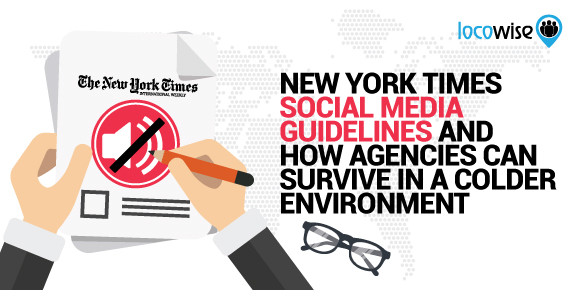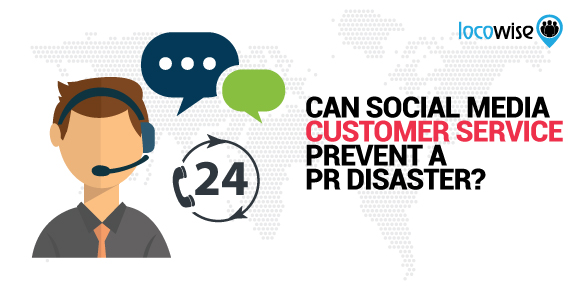New York Times Social Media Guidelines And How Agencies Can Survive In A Colder Environment
Sahail Ashraf posted on 6 November 2017
Quite a dramatic headline, don’t you think? There is a lot going on at the moment, and in recent months especially, the climate in social media has been under constant scrutiny in the press, and even the political sphere.
We all know Donald Trump is the President of the USA, but people weren’t ready for perhaps the one aspect of his presidency that defines him. He’s a social media President.
He has turned to Twitter to comment on other nations, politics in general, and his views on issues that are currently causing problems in America and around the world. We don’t have to regurgitate his tweets in this article, but we know that this has brought about a seismic shift in the way social media influences the world.

That’s right. The world. If anything, the US president’s reliance on social, and the responses to his tweets, show that everyone has to be a little more careful about how they manage social media.
Sure, you can delete tweets, but that rarely happens without a number of people seeing them first. Digital agencies need to be aware of this, not only for their clients, but for the agency staff too. The New York Times has just brought this into sharp focus.
The NY Times and it’s approach to social
The NY Times recently (October 13th) ran a piece online about how it is recognising that social media has a huge amount of influence. It framed this within a set of guidelines that its staff has to follow.
The point it made was clear. With a huge following on NY Times social media properties, as well as the massive amount of influence its key staff have on their own social media accounts, the increased risk of damage to the brand as well as to the staff has now become a source of concern.
The guidelines have made it clear that all NY Times staff with personal accounts and all staff who use the media giant’s official channels have to be very, very careful with how they engage online.
Basically, the NY Times has recognised that the social media environment is not what it used to be, and that its staff (even on their personal accounts) has to consider a set of parameters before it does anything on social.
We will get to the key points shortly, but it’s important to pull out a quote from the piece, assigned to a senior staff member at the NY Times. Nick Confessore added to the piece with his own reflections on his personal social media usage:
“The reality is that my Twitter account is a Times account. The Times does not control it, but the Times is held accountable for what appears on my feed. Indeed, the casual reader interprets my social accounts as an extension of our digital platforms, for good and ill. I think all of us at the Times need to embrace this as the price of our employment by a major media institution. (And in fairness, to the extent my Twitter account is influential or widely read, it is largely because I am employed by The Times.)”
How to behave on social
The new guidelines are a result of a consultation by the NY Times with key journalists and other members of staff. They are of course, not entirely ‘new’, because the brand would have been in a lot of trouble if something wasn’t already in place.
A key point is reputation. With such a huge presence online (and in the world) the brand has asked its members of staff to stay away from partisan and offensive input to any social media conversation. This obviously has key relevance as regards the NY Times and its reporting. Partisanship and other comments that are not completely factual and objective, not to mention inoffensive, would reduce the brand’s impact, and tarnish its image.
Perhaps most tellingly, the brand also stated that ‘the White House doesn’t make a distinction’, which alludes to the danger of making any political comment in an atmosphere where The White House itself is (through the President) fully engaged on social media.
The piece then goes into some detail about the practice of complaining on social media, including customer service related complaints by its staff. Because the staff members are so high profile, it is easy to see that they are employees of the NY Times, and this will immediately link any kind of complaint (with complaining language) with the brand. In other words, don’t come across as negative online, even if you’re talking about a can of beans that was defective.
This may sound silly, but this is a high profile brand, and the staff members obviously identify their employment on their social media accounts.

The most interesting part of the social media guidelines focuses on criticism. Because the brand is so dominant in the news media space, the journalists and other staff members are sometimes criticised by the public, or other commentators. This can also sometimes be quite nasty and inflammatory. The NY Times has put together a response that its members of staff should bear in mind if things get heated on social media, and we think it is right on the money:
If the criticism is especially aggressive or inconsiderate, it’s probably best to refrain from responding. We also support the right of our journalists to mute or block people on social media who are threatening or abusive. (But please avoid muting or blocking people for mere criticism of you or your reporting.)
Remember, this is in a world (and time) where reporters and other public figures are routinely harassed. Women, for example, often have unpleasant and threatening social media responses from people. The NY Times is aware of this, and we think its stance on muting and blocking to be admirable.
How a digital agency can adopt the NY Times’ approach
Any digital agency has to treat its own social media usage as brand-focused, and that includes personal accounts. People from all walks of life are affected by unfortunate incidents on social media, and this includes professionals in education, politics, medicine as well as the commercial arena.
The NY Times finished up by outlining a general guide on how to engage with social media in this new era. With social media being a very dangerous place for anyone who is employed by a brand, this advice is simple, and useful:
If you don’t know whether a social media post conforms to the NY Times standards, ask yourself these questions:
1. Would you express similar views in an article on The Times’s platforms?
2. Would someone who reads your post have grounds for believing that you are biased on a particular issue?
3. If readers see your post and notice that you’re a Times journalist, would that affect their view of The Times’s news coverage as fair and impartial?
4. Could your post hamper your colleagues’ ability to effectively do their jobs?
5. If someone were to look at your entire social media feed, including links and retweets, would they have doubts about your ability to cover news events in a fair and impartial way?
These guidelines are useful for anyone who works for a brand and has a social media profile as an employee and a private individual.
It is worth focusing on this if you work for a digital agency. Why? Because digital agencies have clients. A poor taste tweet by one of your colleagues could quite easily be seen by a prospect. An angry Facebook post on their personal feed could mushroom into something very unpleasant if a client sees it.
Pretty much 99% of us identify our workplace on our social media profiles. And even if we don’t do that, we add to the feeds of our employers. Perhaps a digital agency that has a clear brand should take note of the five points above. It has absolute relevance.
If you are in a position to, review your social media usage policy for your brand. And if it doesn’t cover these points, and especially if it does not cover personal social media accounts, maybe a discussion needs to take place.
Want to have an incredibly effective and efficient way of reporting value to clients? Try Locowise for free, for a whole seven days. It’s on us. You’ll thank us.





